Chapter 14- Competition
1/62
There's no tags or description
Looks like no tags are added yet.
Name | Mastery | Learn | Test | Matching | Spaced |
|---|
No study sessions yet.
63 Terms
Interspecific Interaction
Interactions between different species
Competiton
-/- interaction between 2 species
Schoener’s 6 Mechanisms of Competition
Consumption
Preemptive
Overgrowth
Chemical (allelopathy)
Territorial
Encounter
Consumptive mechanism of competition
One organism inhibits another by consuming a shared nutrient resource
Two mice species competing for food
Preemptive mechanism of competition
One organism occupies space, preventing another from having it
Two species of barnacle competing for space on rock
Overgrowth mechanism of competition
One organism growths directly over another
One species of tree grows over another to access light, shading the smaller tree
Chemical (allelopathy) mechanism of competition
Chemical warfare between competitors
Common among Mediterranean and desert plants
Territorial mechanism of competition
Aggressive behavioral exclusion of an organism from another’s defended territory
Wolves defending territories
Encounter mechanism of competition
Non-territorial encounters reducing growth
Resources
Substances or factors that are consumed by an organism to survive and support population growth with increasing availability
When reduced the result is reduced population growth
Food, light, water, nutrients, space
Resources Examples
Food, light, water, nutrients, space
What are conditions?
May affect growth and reproduction, but they are not consumed by organisms,
Are not resources for which species compete
Ex: Temperature, pH, salinity
Conditions Example
Ex: Temperature, pH, salinity
What is the outcome of competition determined by?
Determined by competition for the limiting resource
Exploitation Competition
Occurs because individuals reduce the supply of shared resources as they use it
Interference Competition
One species directly interferes with the ability of its competitors to use a limiting resource
Liebig’s Law of the Minimum
Limitations on growth not determined by total resources available, but rather availability of scarcest resource
i.e, resource that is the limiting factor
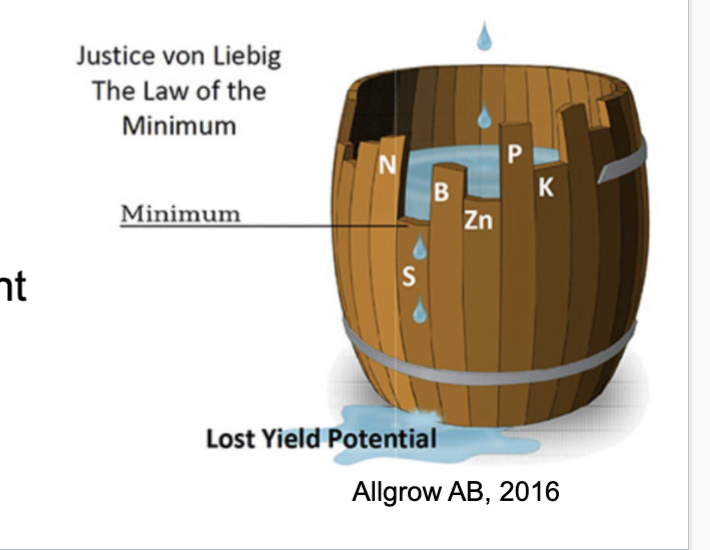
Alleopathy
One species releases toxins harmful to others
Each population increases until…
The supply of some limiting resource becomes depleted
Note: Living things need nutrient resources in relatively fixed ratios to survive and grow
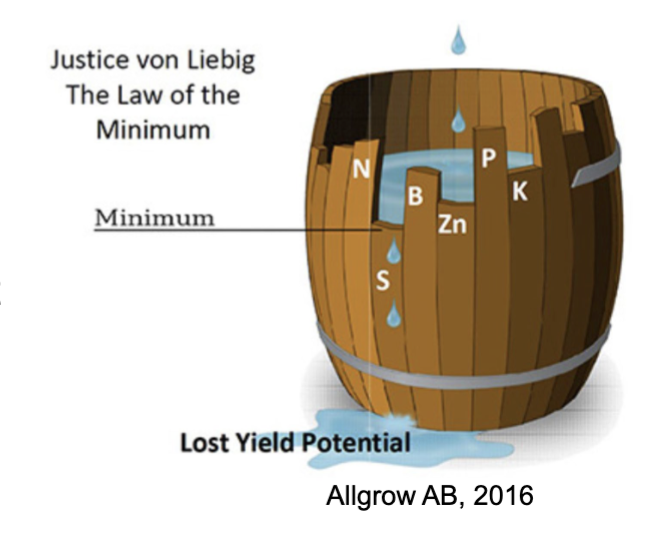
The importance of the concept of the fundamental and realized niche
It is central to understanding the intensity of competition
Fundamental Niche
Niche in the absence of competition
Represents the resources a species could utilize (theoretically) in the absence of all species interactions (including competition)
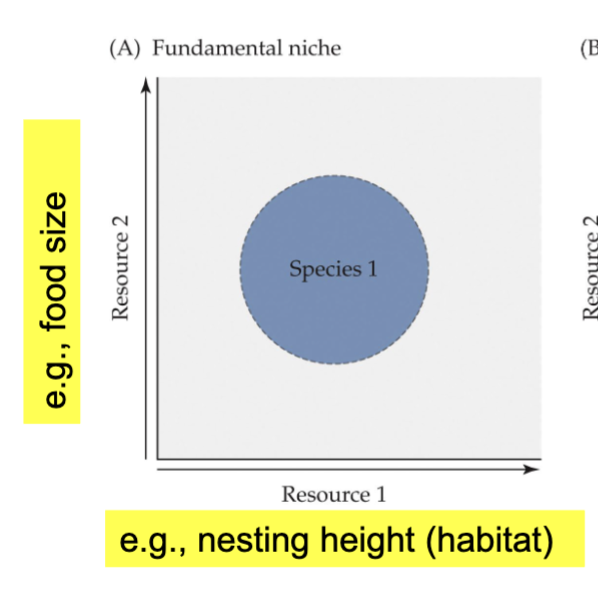
Realized Niche
Niche with competiton
Represents the resources actually utilized by the species after the effects of all species interactions (including competition)
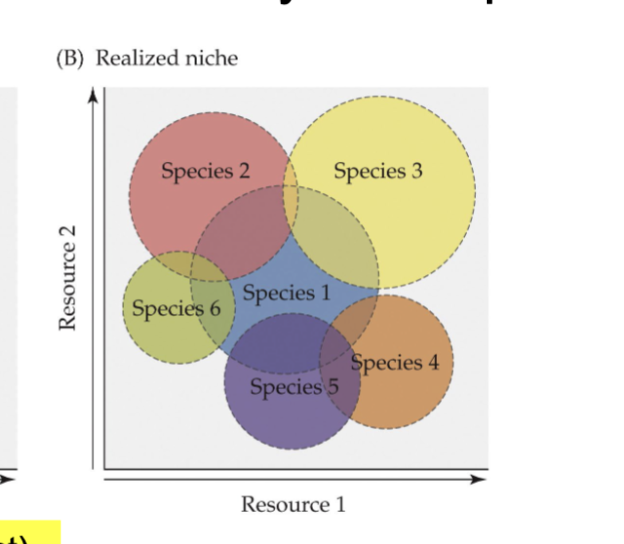
What does the superior competitor have the largest effect against its competitor?
Abundance and distribution of its competitor
Fundamental niche= Niche in absence of competition
Realized Niche= Niche with competition
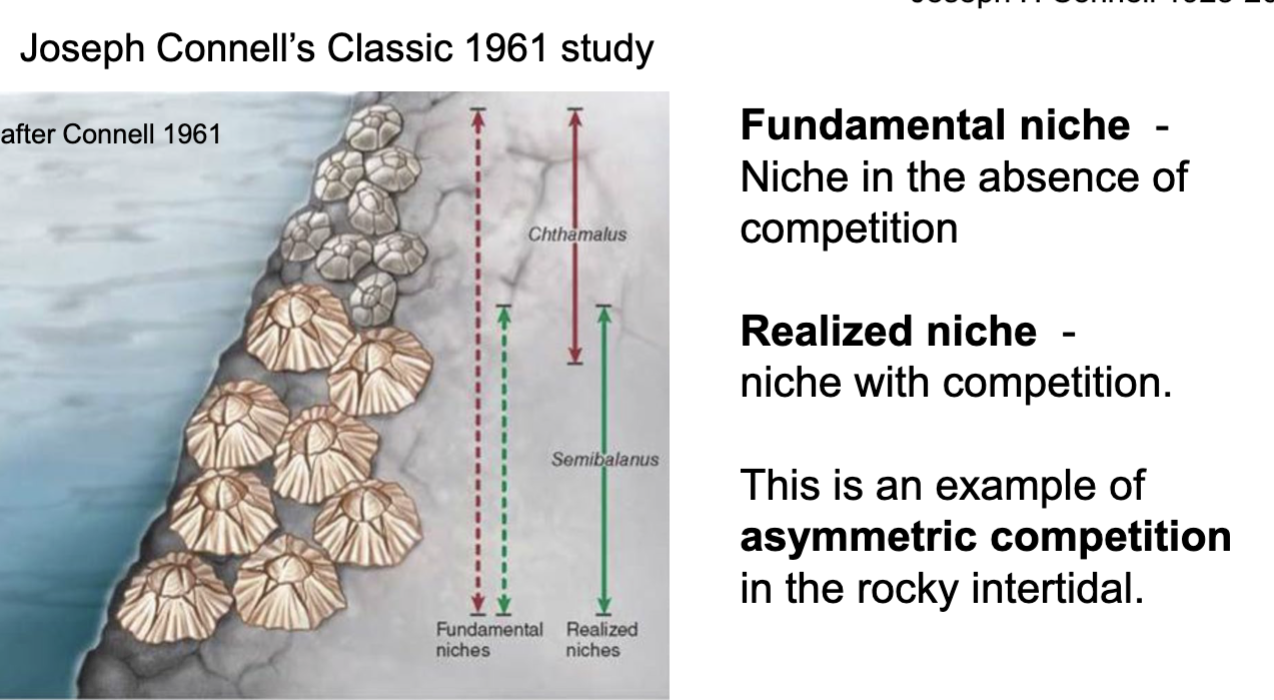
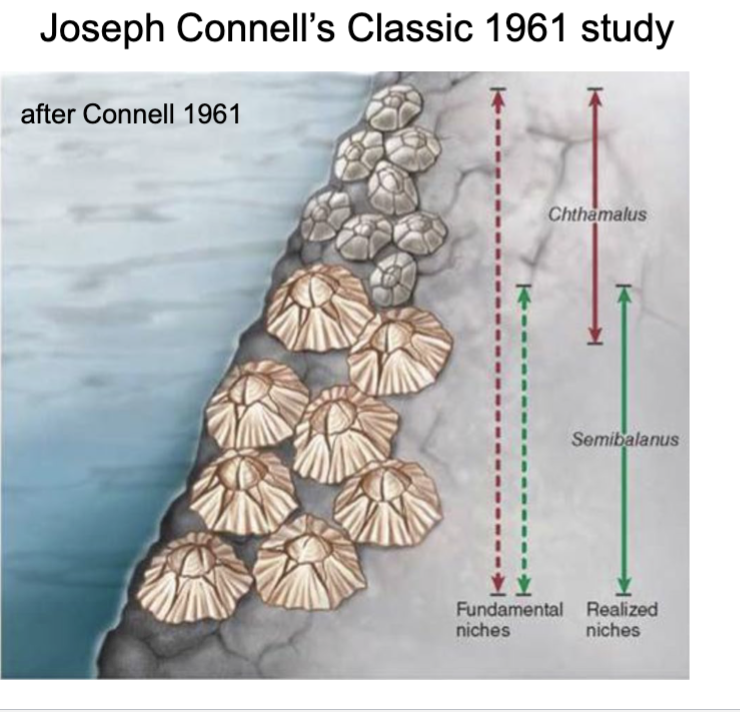
What is this photo an example of?
Asymmetric competition in the rocky intertidal zone
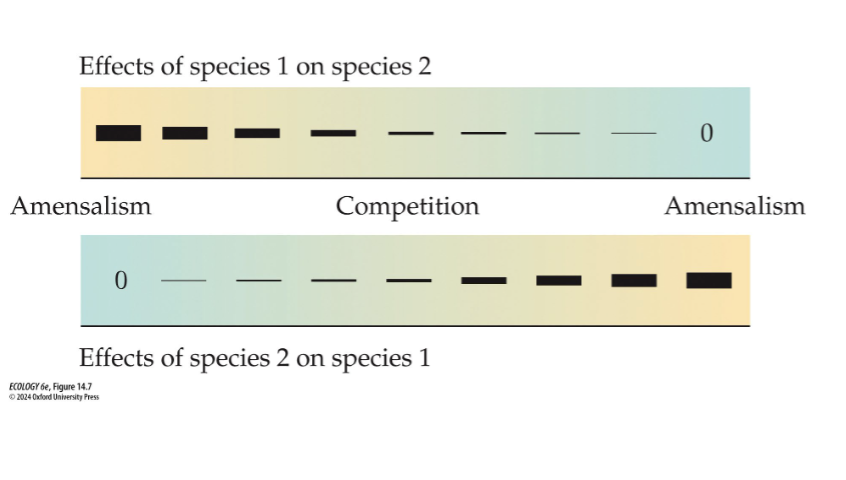
Asymmetric competition
occurs when the effects of competing species on each other are not equal
This is almost always the case in nature
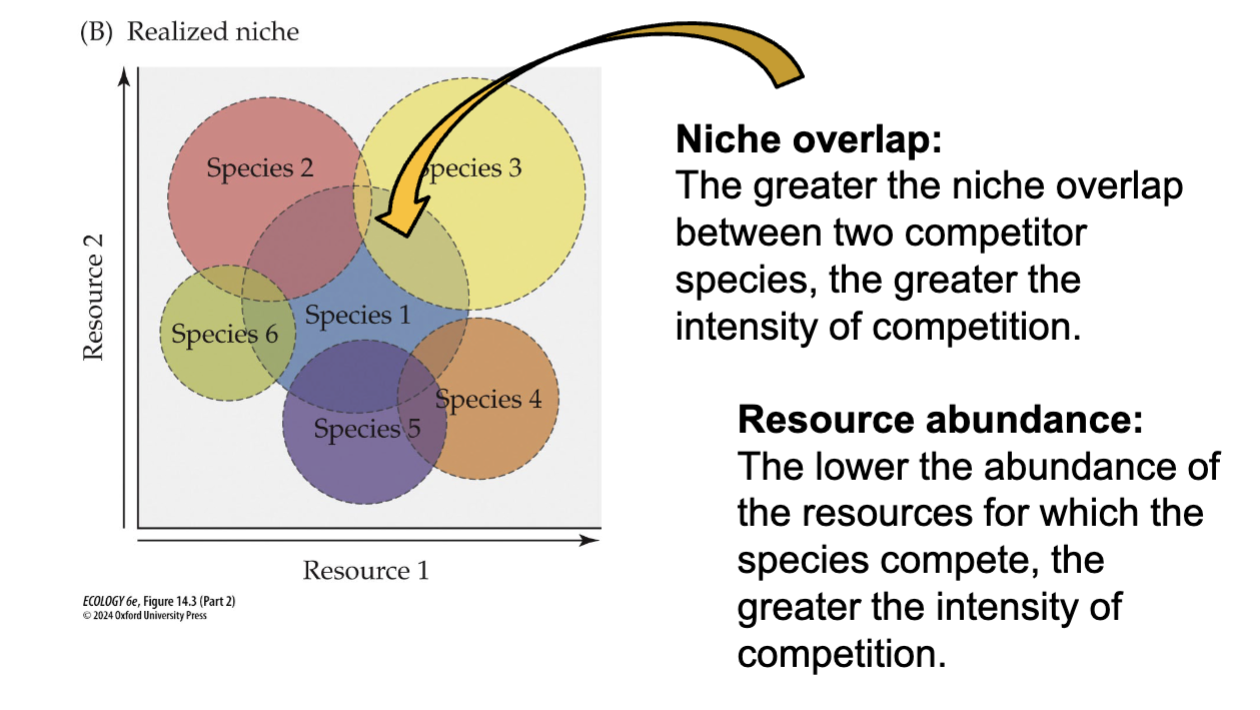
When does intensity of competition increase?
With degree of niche overlap and scarcity of associated resources
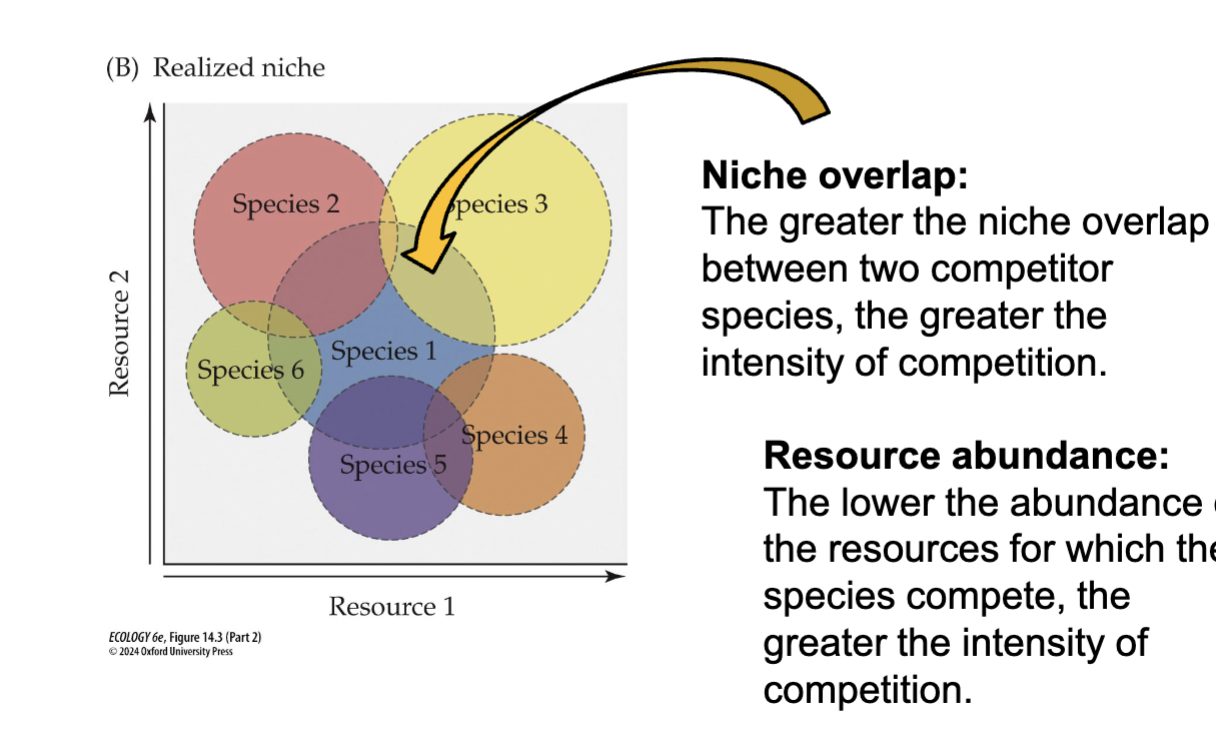
What does greater niche overlap mean?
The greater the intensity of competition
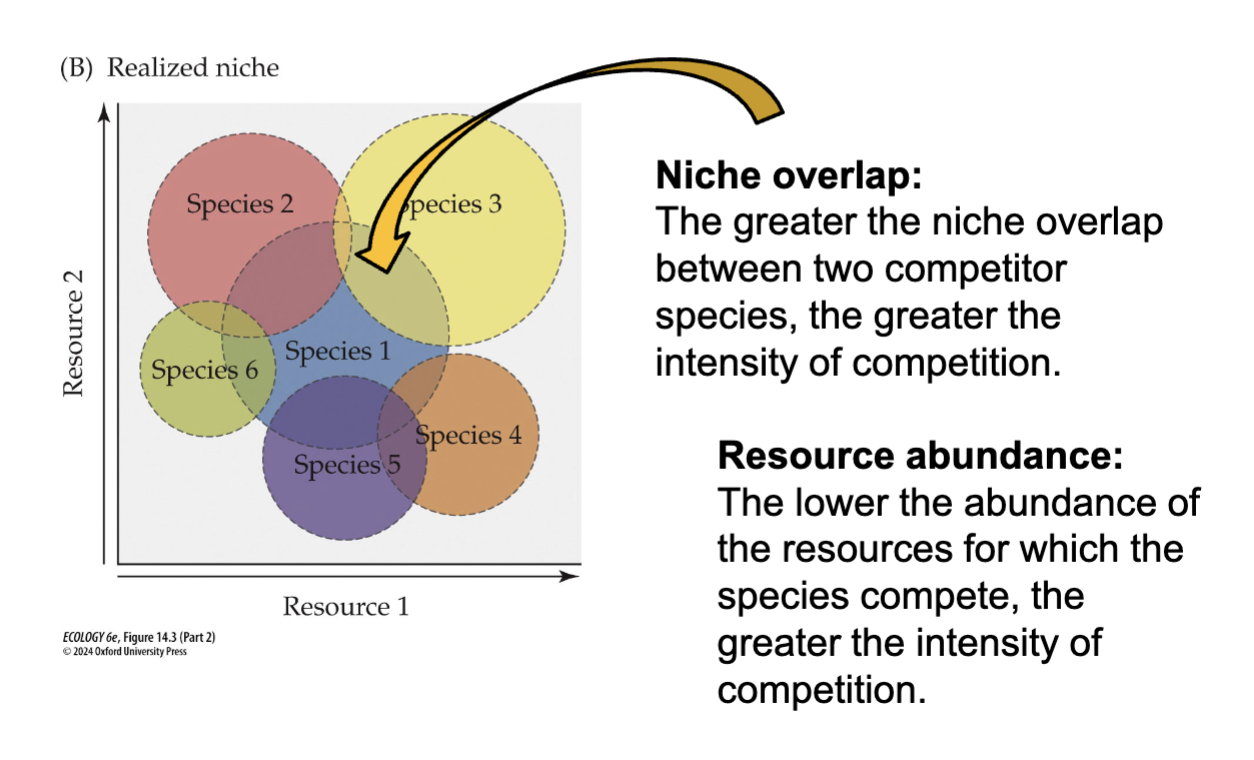
Resource Abundance
The lower the abundance of the resources for which the species compete, the greater the intensity of competition
Amensalism
Term used to describe the most extreme form of asymmetric competition
i.e where one species is affected negatively, and the other is not affected at all
What type of interaction is amensalism (±/0)
-/0
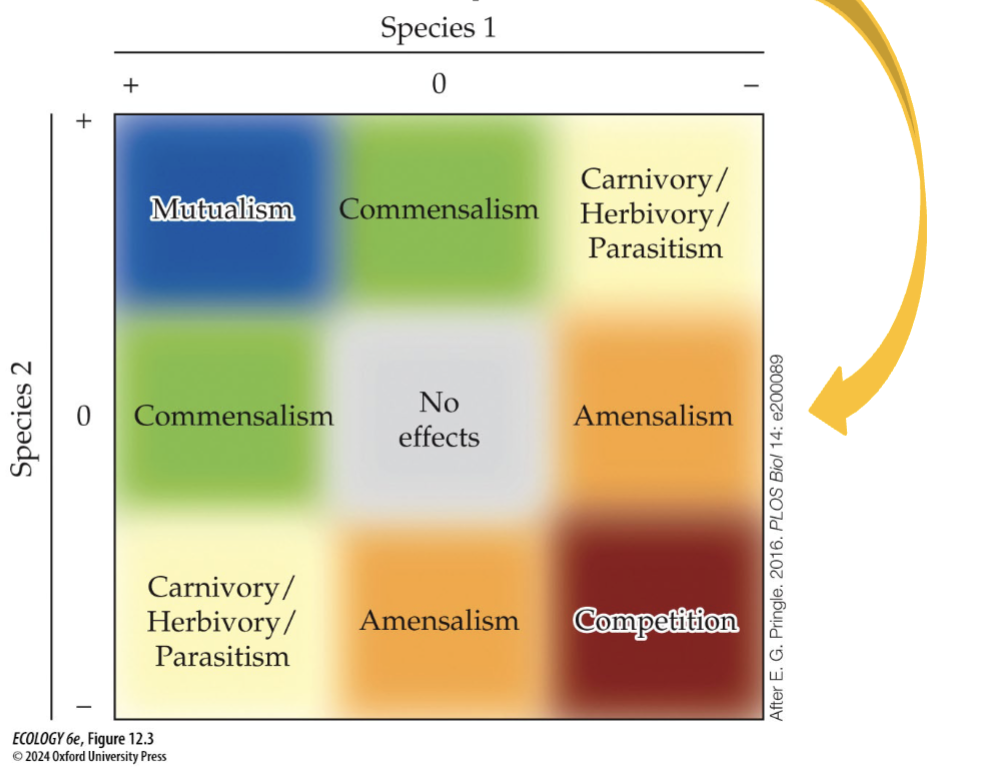
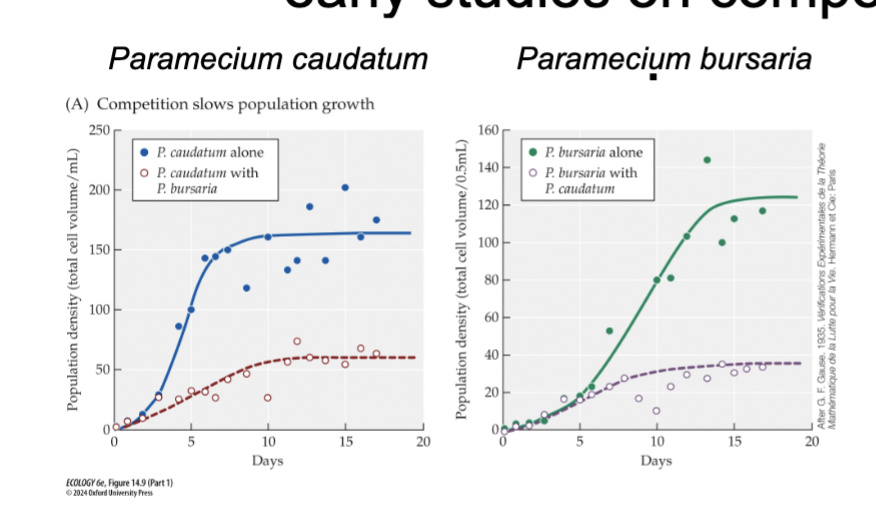
G.F Gause Experiment #1
Protists P. caudatum and P. bursaria were grown both in isolation and together in a liquid medium of bacteria and yeast (2 possible
sources of food).Species demonstrated competitive coexistence, each reducing the abundance of the other, but both persisting.
This occurred because P. caudatum consumed only bacteria (and
was the superior competitor for bacteria), while P. bursaria was able
to consume both bacteria and yeast.
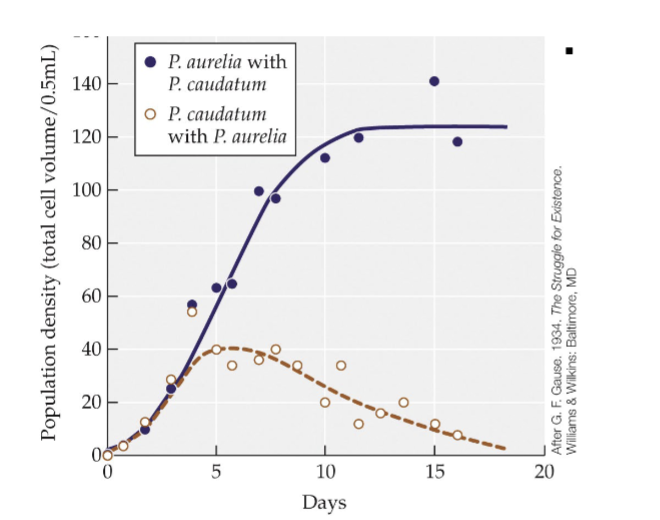
G.F Gause Experiment #2
Protists P. caudatum and P. auralia were grown both in isolation and together in a liquid medium of bacteria and yeast (same 2 possible sources of food).
P. caudatum experienced competitive exclusion (its abundance
declined to ‘0’) as a result of competing with P. auralia.This occurred because P. caudatum and P. auralia both consumed
only bacteria, and P. auralia was the superior competitor for bacteria

What did Gause propose as the result of his two experiments?
The competitive exclusion principle
Original version: Two species cannot coexist when limited by the same resource
New modified version:
Competitors that use a limiting resource in the same way cannot coexist.
Original version of Competitive Exclusion Principle
Two species cannot coexist when limited by the same resource
New Modified version of Competitive Exclusion Principles
Competitors that use a limiting resource in the same way cannot coexist
How can species coexist consuming the same limiting resources?
Through resource partitioning
Also known as niche partitioning
Schoener findings in Anolis lizards
found that Anolis lizards of different species had the same food sources (the same limiting resources) but coexisted by specializing on feeding from different places in the plant canopy and in the sun or in the shade

When do two species engage in resource partitioning?
When they utilize the same limiting resource in different ways
Overtime evolutionary time what can competition between closely related species drive
Character displacement
Character displacement
An evolutionary process where two similar species, when coexisting in the same environment, diverge in certain traits (like morphology, behavior, or physiology) to reduce competition for resources, resulting in greater differences between them compared to when they are found in separate environments.

More Niche Overlap
When species first come together in the same place

Less Niche Overlap
As a result of natural selection over evolutionary time, the two species increasingly specialize on food of differing size, reducing competition

Character Displacement Example
Patterns consistent with the operation of character displacement have been observed among Darwin’s finches over the Galapagos Islands
Differences in beak depth correlate with specialization on specific sources of food
Lotka-Volterra Model For Competition Formula
Species 1: dN1 /dt = r 1 N1 (K1 – N1 – αN2 )/K1
Species 2: dN2 /dt = r 2 N2 (K2 – N2 – βN1 )/K2
What does α mean in Lotka- Volterra Model for competition represent
The effect an individual of species 2 has on the population growth of species 1
What does β mean in Lotka- Volterra Model for competition represent
The effect an individual of species 1 has on the population growth of species 2
If α > 1.0, then sp. 2 …
individuals carry greater weight than sp. 1 individuals.
If α = 1.0, then sp. 2…
individuals carry the same weight as sp. 1 individuals.
If α < 1.0, then sp. 2 individuals…
carry less weight than sp. 1 individuals. Same relationships with β
What does a Higher competition coefficient (β, α) mean?
A higher competition coefficient indicates that the species has a greater negative effect on the growth rate of its competitor.
What does a Higher carrying capacity (K) mean?
A higher carrying capacity indicates that the species uses available resources more efficiently.
Four possible outcomes to L-V competition are based on the relative K and α/β of the two species.
Species 1 Zero- Growth Isocline formula
N1 = K1 – αN2
Species 2 Zero- Growth Isocline formula
N2 = K2 – βN1
Components of Zero Growth Isocline Graph Species 1
X- intercept: K1 (Math: N1=K1-α(0): N1=K1)
Y-intercept: K1/α (Math: 0=K1-αN2: N2=K1/α)
Population size of species 1 increases below zero growth isocline line
Components of Zero Growth Isocline Graph Species 2
X- intercept: K2/β (Math: 0=K2-βN1: N1=K2/β)
Y-intercept: K2 (Math: N2=K2-0: N2=K2)
Population size of species 2 increases below zero growth isocline line
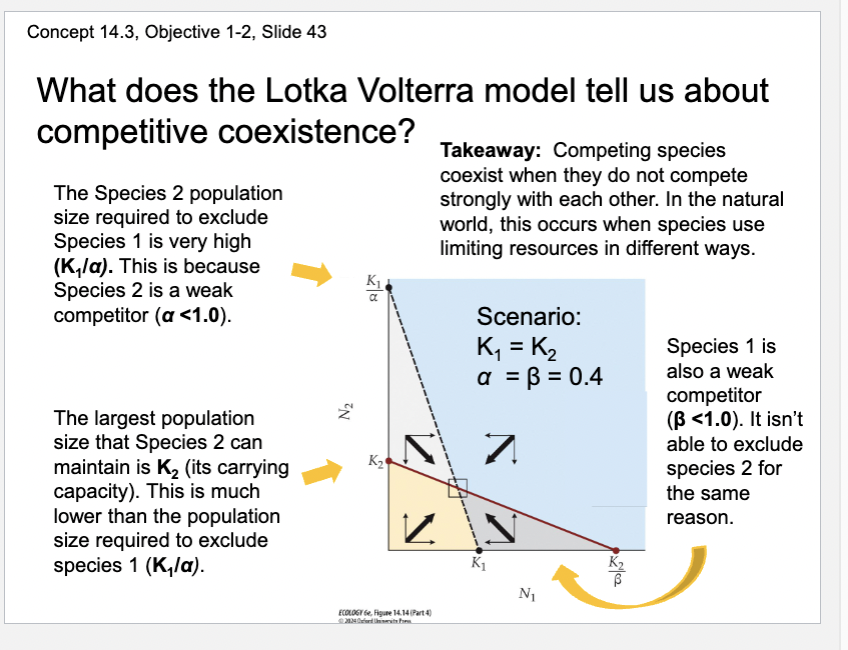
What does model tell us about competative coexistence
The largest population size that Species 2 can maintain is K2 (its carrying capacity). This is much lower than the population size required to exclude species 1 (K1 /α).
Species 1 is also a weak competitor (β <1.0). It isn’t able to exclude species 2 for the same reason.
The Species 2 population size required to exclude Species 1 is very high (K1 /α). This is because Species 2 is a weak competitor (α <1.0).
Takeaway: Competing species coexist when they do not compete strongly with each other. In the natural world, this occurs when species use limiting resources in different ways.
Scenario:
K1 = K2
α = β = 0.4
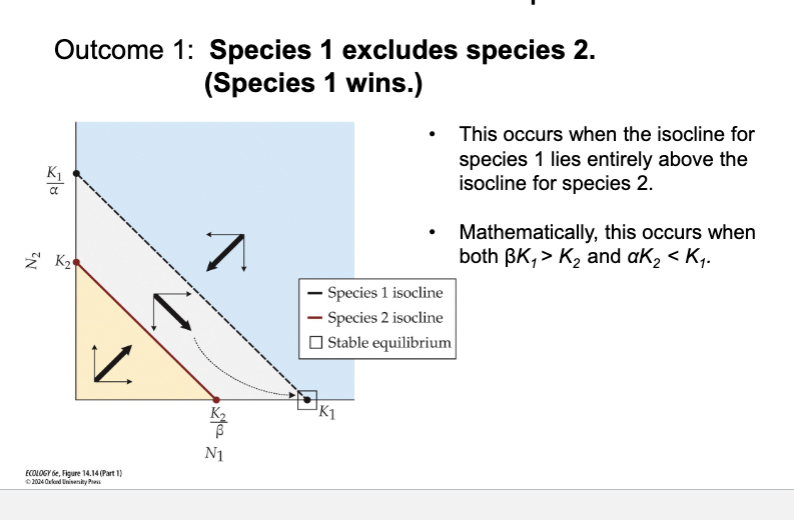
Outcome 1: Species 1 excludes species 2.
(Species 1 wins.)
This occurs when the isocline for species 1 lies entirely above the isocline for species 2.
Mathematically, this occurs when both βK1 > K2 and αK2 < K1 .
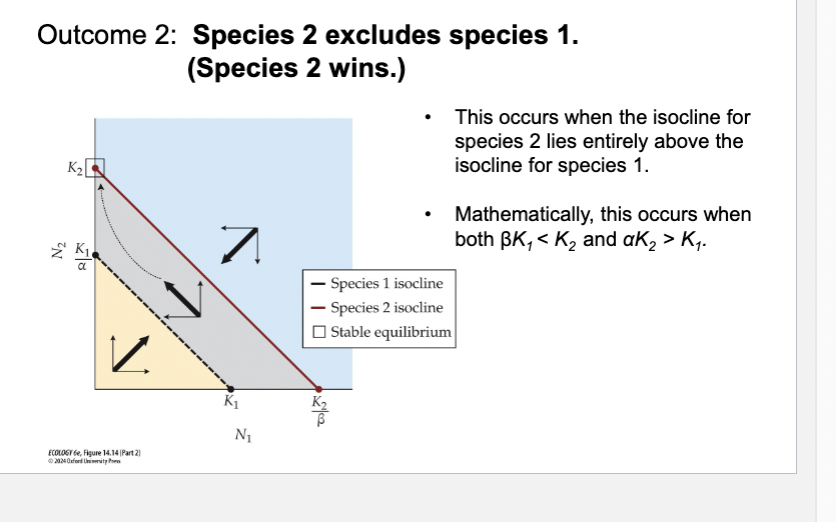
Outcome 2: Species 2 excludes species 1.
(Species 2 wins.)
This occurs when the isocline forspecies 2 lies entirely above the isocline for species 1.
Mathematically, this occurs whenboth βK1 < K2 and αK 2 > K1 .
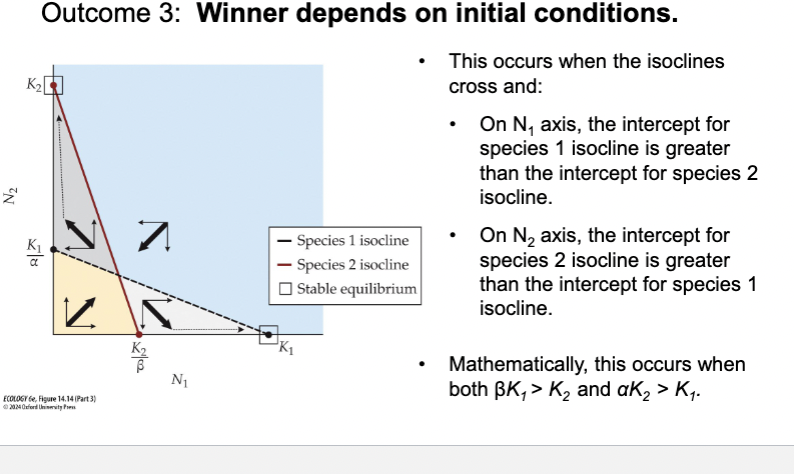
Outcome 3: Winner depends on initial conditions.
This occurs when the isoclines
cross and:
• On N1 axis, the intercept for
species 1 isocline is greater
than the intercept for species 2
isocline.
• On N2 axis, the intercept for
species 2 isocline is greater
than the intercept for species 1
isocline.
• Mathematically, this occurs when
both βK 1 > K2 and αK 2 > K1 .
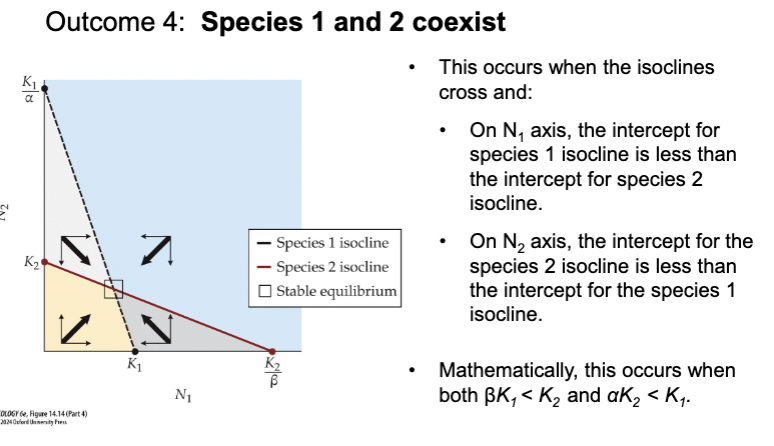
Outcome 4: Species 1 and 2 coexist
This occurs when the isoclines
cross and:
• On N1 axis, the intercept for
species 1 isocline is less than
the intercept for species 2
isocline.
• On N2 axis, the intercept for the
species 2 isocline is less than
the intercept for the species 1
isocline.
• Mathematically, this occurs when
both βK 1 < K2 and αK 2 < K1 .
The outcome of competition can be influenced by predation and herbivory
Predators sometimes suppress dominant competitors, preventing competitive exclusion of inferior competitor species
Sea stars preferentially consume Balanus (the superior competitor) but not Chthamalus (the inferior competitor, in Connells 1961 experiment
A.G Tansley experiment demonstrated…
competition between closely related species.
Galium saxatile: normally found on
acid, peaty soils.Galium sylvestre: normally found on
limestone hills and pastures.Experiment:
The two species were grown alone
and together on in each of the two
different soil types
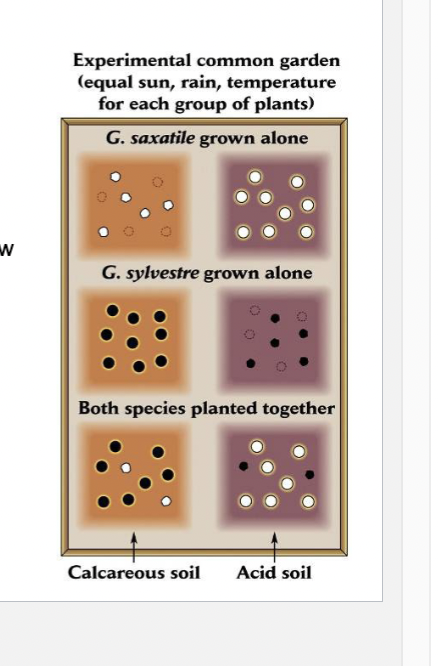
Tansley’s results:
Grown alone, each species performed
better on its preferred soil, but could
also grow on other soil.
Grown together, each species overgrew
and shaded the other species on their
preferred soil type.
Conclusion: Each species was at a
disadvantage in competition when not
grown on their preferred soil type.
Takeaway: Outcome of competition
between species can depend on
environment.